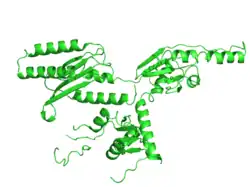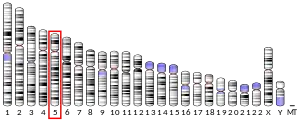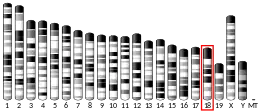Eukaryotic translation termination factor 1
Eukaryotic translation termination factor 1 (eRF1), also known as TB3-1, is a protein that in humans is encoded by the ETF1 gene.[5][6][7]
| ETF1 | |||||||||||||||||||||||||||||||||||||||||||||||||||
|---|---|---|---|---|---|---|---|---|---|---|---|---|---|---|---|---|---|---|---|---|---|---|---|---|---|---|---|---|---|---|---|---|---|---|---|---|---|---|---|---|---|---|---|---|---|---|---|---|---|---|---|
 | |||||||||||||||||||||||||||||||||||||||||||||||||||
| |||||||||||||||||||||||||||||||||||||||||||||||||||
| Identifiers | |||||||||||||||||||||||||||||||||||||||||||||||||||
| Aliases | ETF1, D5S1995, ERF, ERF1, RF1, SUP45L1, TB3-1, eukaryotic translation termination factor 1 | ||||||||||||||||||||||||||||||||||||||||||||||||||
| External IDs | OMIM: 600285 MGI: 2385071 HomoloGene: 3475 GeneCards: ETF1 | ||||||||||||||||||||||||||||||||||||||||||||||||||
| |||||||||||||||||||||||||||||||||||||||||||||||||||
| |||||||||||||||||||||||||||||||||||||||||||||||||||
| |||||||||||||||||||||||||||||||||||||||||||||||||||
| |||||||||||||||||||||||||||||||||||||||||||||||||||
| |||||||||||||||||||||||||||||||||||||||||||||||||||
| Wikidata | |||||||||||||||||||||||||||||||||||||||||||||||||||
| |||||||||||||||||||||||||||||||||||||||||||||||||||
In eukaryotes and archaea, this is the sole class 1 release factor (eRF) which recognizes all three stop codons. The overall process of termination is similar in bacteria, but in the latter 2 separate codon-recognizing release factors exist, RF1 and RF2. [8]
Function
Termination of protein biosynthesis and release of the nascent polypeptide chain are signaled by the presence of an in-frame stop codon at the aminoacyl site of the ribosome. The process of translation termination is universal and is mediated by protein release factors (RFs) and GTP. A class 1 RF recognizes the stop codon and promotes the hydrolysis of the ester bond linking the polypeptide chain with the peptidyl site tRNA, a reaction catalyzed at the peptidyl transferase center of the ribosome. Class 2 RFs, which are not codon specific and do not recognize codons, stimulate class 1 RF activity and confer GTP dependency upon the process. In bacteria, both class 1 RFs, RF1 and RF2, recognize UAA; however, UAG and UGA are decoded specifically by RF1 and RF2, respectively. In eukaryotes, eRF1, or ETF1, the functional counterpart of RF1 and RF2, functions as an omnipotent RF, decoding all 3 stop codons.[5][7]
References
- GRCh38: Ensembl release 89: ENSG00000120705 - Ensembl, May 2017
- GRCm38: Ensembl release 89: ENSMUSG00000024360 - Ensembl, May 2017
- "Human PubMed Reference:". National Center for Biotechnology Information, U.S. National Library of Medicine.
- "Mouse PubMed Reference:". National Center for Biotechnology Information, U.S. National Library of Medicine.
- "Entrez Gene: eukaryotic translation termination factor 1".
- Grenett HE, Eipers PG, Kidd VJ, Bounelis P, Fuller GM (January 1992). "Chromosomal localization of a human cDNA containing a DIDS binding domain and demonstrating high homology to yeast omnipotent suppressor 45". Somat. Cell Mol. Genet. 18 (1): 97–102. doi:10.1007/BF01233452. PMID 1546371. S2CID 35363644.
- Frolova L, Le Goff X, Rasmussen HH, Cheperegin S, Drugeon G, Kress M, Arman I, Haenni AL, Celis JE, Philippe M (December 1994). "A highly conserved eukaryotic protein family possessing properties of polypeptide chain release factor". Nature. 372 (6507): 701–3. Bibcode:1994Natur.372..701F. doi:10.1038/372701a0. PMID 7990965. S2CID 4264934.
- Kisselev L, Ehrenberg M, Frolova L (January 2003). "Termination of translation: interplay of mRNA, rRNAs and release factors?". EMBO J. 22 (2): 175–82. doi:10.1093/emboj/cdg017. PMC 140092. PMID 12514123.
Further reading
- Kashima I, Yamashita A, Izumi N, Kataoka N, Morishita R, Hoshino S, Ohno M, Dreyfuss G, Ohno S (2006). "Binding of a novel SMG-1-Upf1-eRF1-eRF3 complex (SURF) to the exon junction complex triggers Upf1 phosphorylation and nonsense-mediated mRNA decay". Genes Dev. 20 (3): 355–67. doi:10.1101/gad.1389006. PMC 1361706. PMID 16452507.
- Chavatte L, Seit-Nebi A, Dubovaya V, Favre A (2002). "The invariant uridine of stop codons contacts the conserved NIKSR loop of human eRF1 in the ribosome". EMBO J. 21 (19): 5302–11. doi:10.1093/emboj/cdf484. PMC 129024. PMID 12356746.
- Janzen DM, Geballe AP (2004). "The effect of eukaryotic release factor depletion on translation termination in human cell lines". Nucleic Acids Res. 32 (15): 4491–502. doi:10.1093/nar/gkh791. PMC 516063. PMID 15326224.
- Rual JF, Venkatesan K, Hao T, Hirozane-Kishikawa T, Dricot A, Li N, Berriz GF, Gibbons FD, Dreze M, Ayivi-Guedehoussou N, Klitgord N, Simon C, Boxem M, Milstein S, Rosenberg J, Goldberg DS, Zhang LV, Wong SL, Franklin G, Li S, Albala JS, Lim J, Fraughton C, Llamosas E, Cevik S, Bex C, Lamesch P, Sikorski RS, Vandenhaute J, Zoghbi HY, Smolyar A, Bosak S, Sequerra R, Doucette-Stamm L, Cusick ME, Hill DE, Roth FP, Vidal M (2005). "Towards a proteome-scale map of the human protein-protein interaction network". Nature. 437 (7062): 1173–8. Bibcode:2005Natur.437.1173R. doi:10.1038/nature04209. PMID 16189514. S2CID 4427026.
- Ivanova EV, Alkalaeva EZ, Birsdall B, Kolosov PM, Pol'shakov VI, Kiselev LL (2008). "[Interface of the interaction of the middle domain of human translation termination factor eRF1 with eukaryotic ribosomes]". Mol. Biol. (Mosk.). 42 (6): 1056–66. doi:10.1134/S0026893308060162. PMID 19140327. S2CID 38843938.
- Hauryliuk V, Zavialov A, Kisselev L, Ehrenberg M (2006). "Class-1 release factor eRF1 promotes GTP binding by class-2 release factor eRF3". Biochimie. 88 (7): 747–57. doi:10.1016/j.biochi.2006.06.001. PMID 16797113.
- Inge-Vechtomov S, Zhouravleva G, Philippe M (2003). "Eukaryotic release factors (eRFs) history". Biol. Cell. 95 (3–4): 195–209. doi:10.1016/S0248-4900(03)00035-2. PMID 12867083. S2CID 19468756.
- Andér M, Aqvist J (2009). "Does glutamine methylation affect the intrinsic conformation of the universally conserved GGQ motif in ribosomal release factors?". Biochemistry. 48 (15): 3483–9. doi:10.1021/bi900117r. PMID 19265422.
- Kobayashi Y, Zhuang J, Peltz S, Dougherty J (2010). "Identification of a cellular factor that modulates HIV-1 programmed ribosomal frameshifting". J. Biol. Chem. 285 (26): 19776–84. doi:10.1074/jbc.M109.085621. PMC 2888388. PMID 20418372.
- Sowa ME, Bennett EJ, Gygi SP, Harper JW (2009). "Defining the human deubiquitinating enzyme interaction landscape". Cell. 138 (2): 389–403. doi:10.1016/j.cell.2009.04.042. PMC 2716422. PMID 19615732.
- Ilegems E, Pick HM, Vogel H (2004). "Downregulation of eRF1 by RNA interference increases mis-acylated tRNA suppression efficiency in human cells". Protein Eng. Des. Sel. 17 (12): 821–7. doi:10.1093/protein/gzh096. PMID 15716307.
- Kolosov P, Frolova L, Seit-Nebi A, Dubovaya V, Kononenko A, Oparina N, Justesen J, Efimov A, Kisselev L (2005). "Invariant amino acids essential for decoding function of polypeptide release factor eRF1". Nucleic Acids Res. 33 (19): 6418–25. doi:10.1093/nar/gki927. PMC 1283522. PMID 16282590.
- Andersen JS, Lam YW, Leung AK, Ong SE, Lyon CE, Lamond AI, Mann M (2005). "Nucleolar proteome dynamics". Nature. 433 (7021): 77–83. Bibcode:2005Natur.433...77A. doi:10.1038/nature03207. PMID 15635413. S2CID 4344740.
- Figaro S, Scrima N, Buckingham RH, Heurgué-Hamard V (2008). "HemK2 protein, encoded on human chromosome 21, methylates translation termination factor eRF1". FEBS Lett. 582 (16): 2352–6. doi:10.1016/j.febslet.2008.05.045. PMID 18539146. S2CID 38589664.
- Chavatte L, Frolova L, Laugâa P, Kisselev L, Favre A (2003). "Stop codons and UGG promote efficient binding of the polypeptide release factor eRF1 to the ribosomal A site". J. Mol. Biol. 331 (4): 745–58. doi:10.1016/S0022-2836(03)00813-1. PMID 12909007.
- Bohnsack MT, Regener K, Schwappach B, Saffrich R, Paraskeva E, Hartmann E, Görlich D (2002). "Exp5 exports eEF1A via tRNA from nuclei and synergizes with other transport pathways to confine translation to the cytoplasm". EMBO J. 21 (22): 6205–15. doi:10.1093/emboj/cdf613. PMC 137205. PMID 12426392.
- Gevaert K, Goethals M, Martens L, Van Damme J, Staes A, Thomas GR, Vandekerckhove J (2003). "Exploring proteomes and analyzing protein processing by mass spectrometric identification of sorted N-terminal peptides". Nat. Biotechnol. 21 (5): 566–9. doi:10.1038/nbt810. PMID 12665801. S2CID 23783563.
- Funakoshi Y, Doi Y, Hosoda N, Uchida N, Osawa M, Shimada I, Tsujimoto M, Suzuki T, Katada T, Hoshino S (2007). "Mechanism of mRNA deadenylation: evidence for a molecular interplay between translation termination factor eRF3 and mRNA deadenylases". Genes Dev. 21 (23): 3135–48. doi:10.1101/gad.1597707. PMC 2081979. PMID 18056425.
- Ivanova EV, Kolosov PM, Birdsall B, Kelly G, Pastore A, Kisselev LL, Polshakov VI (2007). "Eukaryotic class-1 translation termination factor eRF1: the NMR structure of the middle domain involved in triggering ribosome-dependent peptidyl-tRNA hydrolysis". FEBS Journal. 274 (16): 4223–37. doi:10.1111/j.1742-4658.2007.05949.x. PMID 17651434. S2CID 6429986.
- Mantsyzov AB, Ivanova EV, Birdsall B, Alkalaeva EZ, Kryuchkova PN, Kelly G, Frolova LY, Polshakov VI (2010). "NMR Solution Structure and Function of the C-terminal Domain of Eukaryotic Polypeptide Release Factor eRF1". FEBS Journal. 277 (12): 2611–27. doi:10.1111/j.1742-4658.2010.07672.x. PMC 2984548. PMID 20553496.
External links
- Termination+Release+Factor at the U.S. National Library of Medicine Medical Subject Headings (MeSH)
This article incorporates text from the United States National Library of Medicine, which is in the public domain.



